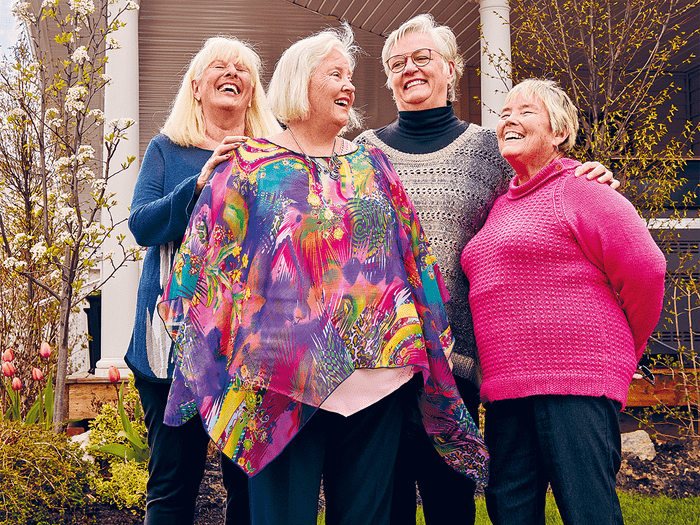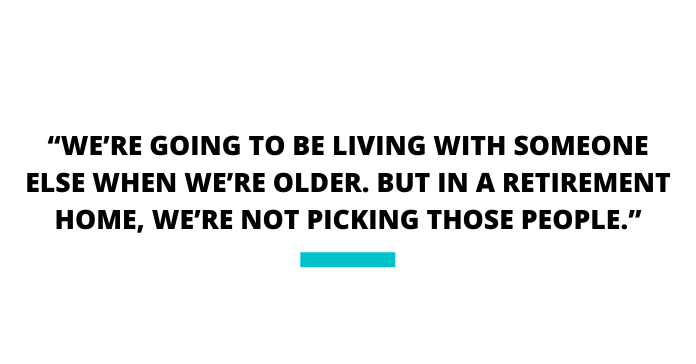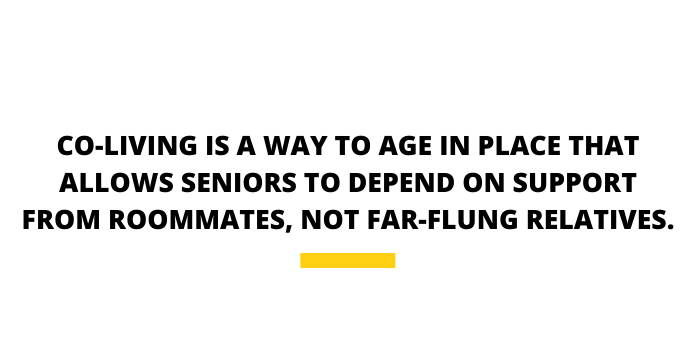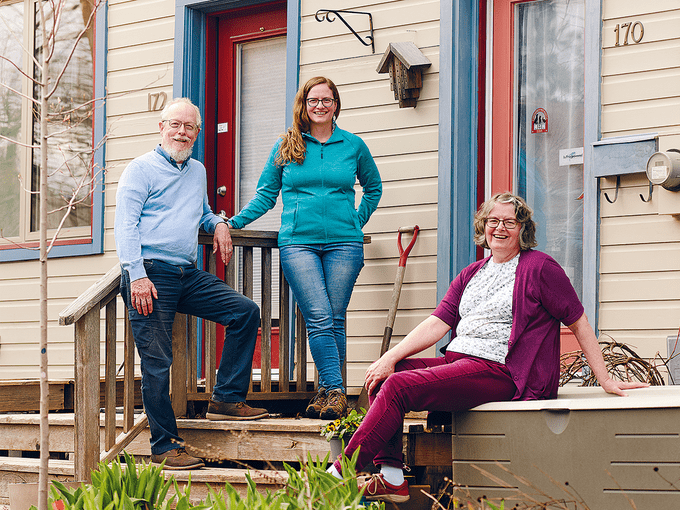The New Golden Girls

Fed up with traditional retirement living, these Canadian seniors are joining forces to age in place.
When Louise Bardswich helped her mother move into a retirement residence in 2012, she realized she’d never want to live in one herself. The lifestyle—scheduled meals and activities, sharing space with strangers—didn’t appeal to her, nor did the price tag. Depending on the extent of care she might need one day, a spot in a seniors’ home could end up costing her between $2,000 and $6,000 a month on average, which would quickly eat up the money she’d saved working as a college administrator in Toronto and, later, as a management consultant in Port Perry, Ontario. “I thought of myself 20 years out, did the calculations and realized it wasn’t in the cards,” says Bardswich, who was widowed and in her early 60s at the time. “I was not going to be able to afford that.”
She shared her worries with her friend and former colleague Martha Casson, who was in her 60s, divorced and living with her elderly mother. Together, they began researching alternatives to typical old-age living and found examples, both locally and internationally, of seniors moving in and aging together. It seemed cheaper and more independent than a retirement home, and safer and more social than living alone. So, they asked themselves, why not give it a try? “The reality is that, in many cases, we’re going to be living with someone else anyway,” says Casson. “But if it’s 100 other people in a retirement home, we’re not picking those people or controlling our lives.”
Soon after, the women shared their findings with Beverly Brown—a friend from Bardswich’s curling club. She loved the idea and thought her friend Sandy McCully would, too. Brown, who was divorced, and McCully, who was widowed, were retired from nursing and wondering what to do with their empty, too-big suburban houses. Like Bardswich and Casson, they were among the 91 per cent of Ontario seniors who, according to a 2020 survey conducted for Home Care Ontario, wanted to age in their own home, not an institution. They also didn’t want to burden their families, calling their children every time they needed the lawn mowed or driveway shovelled. As McCully puts it, “My two boys aren’t into, quote, ‘this caregiving thing.’”

By 2016, the women had decided to sell their homes, and each chip in $275,000 to buy and renovate a two-storey, nearly 5,000-square-foot house in Port Perry. It felt like a good deal. The renovations included outfitting their new home with a wide porch and fresh vinyl siding. They were confident they’d get a return on their investment; the money they’d put into the house would grow and be inherited, not wither away paying for assisted living.
Plus, the location was great: the house is close to grocery stores, and the lakeside town of 10,000 is about an hour’s drive northeast of Toronto, with a picturesque Victorian-era downtown and plenty of retirees. The house even comes with a personal connection: Brown’s great-great-grandfather had helped build it in 1855. The women planned to share the kitchen and living room, but each would have a private suite with a bedroom, sitting area and accessible bathroom.
Before they moved in, the four women drafted and signed a lengthy legal agreement to solidify the details of their co-living arrangement. They’d each pay $1,700 a month to cover property taxes, home insurance, utilities, Internet, cable, maintenance, snow removal, weekly cleaning services and the cost of food and wine, both of which they share freely. The agreement also stipulated what would happen if one of them left the house (the other women could buy her out, or she could sell her share to an agreed-upon buyer). Later on, they also discussed what would happen if someone got a boyfriend (this would be okay, so long as everyone liked him and he helped around the house).
When they arrived in November 2016, the Golden Girls of Port Perry, as neighbours started calling them, were on their best behaviour. They held regular meetings, often with a glass of wine in hand, to discuss house matters (which of their cumulative 24 spatulas were they going to keep?) and disputes (who keeps leaving that dirty cup in the sink?). But as they turned from acquaintances to friends, things loosened up. They cooked and baked for one another, gardened together and entertained each other’s kids and grandchildren. When U.S. President Joe Biden was inaugurated, they celebrated with champagne.
For years, experts and watchdogs have warned about fatal flaws in long-term care: the system is confusing to navigate; elder abuse is alarmingly commonplace; and staff are often stretched thin and can face poor working conditions, leaving them unable to provide proper care. Canada’s current stock of just over 2,000 long-term care residences is also unprepared to meet the needs of an aging population. It’s estimated that there will be 10.4 million seniors in Canada by 2037, 68 per cent more than in 2017. Without an influx of new long-term care beds, many of them will be stuck on years-long waitlists. Others simply won’t be able to afford the necessary care.
The pandemic has exacerbated these problems. More than two-thirds of COVID-19 deaths in Canada have occurred in long-term care settings. Throughout 2020, baby boomers and Gen Xers were also forced to decide whether or not to pull their parents out of care, where they were isolated in their rooms and at severe risk of dying from the virus. Winnipegger Lois Coleman Neufeld removed her 92-year-old mother, Joy, from a care home in the early days of the pandemic. Joy, who has dementia, thrived living with her daughter: she is no longer depressed due to isolation, and she walks more than she used to. But now Coleman Neufeld, who is on long-term disability pay, worries about how long she’ll be able to look after her mother. What if her own health deteriorates and she needs a caregiver herself?
“That’s a hard, hard thing to think about,” she told CBC News. “The question of taking my mother out wasn’t a huge issue to resolve. The biggest issue was: can I manage it?”
The option of staying in your own home as you grow older has grown more attractive during the pandemic, but aging in place is easier said than done. Seniors often need familial or hired help maintaining their home and their health. At the same time, fewer than half of Canadians feel personally or financially prepared to become caregivers, according to a report by Telus Health and the National Institute on Aging.

Co-living, the kind of arrangement espoused by the Golden Girls, is one potential solution—a way to age in place that depends on support from retired roommates, not far-flung relatives with full-time jobs and families of their own. Co-living is expected to become increasingly common in the coming decades. In fact, the Golden Girls of Port Perry appear on the cover of a co-ownership guide released by the Ontario provincial government in 2019 that provides practical tips on how to purchase property with others.
Across Canada, organizations are now springing up to help Canadians explore late-life housing options beyond “park here and wait for the end,” as Janet Torge, the founder of Radical Resthomes, puts it. Her Montreal-based group runs workshops on senior co-living and is currently developing a pilot project that will match lone seniors with multi-generational families, such as new immigrants or single parents, demographics that could benefit from each other’s support. Torge has spoken to hundreds of current and soon-to-be seniors interested in co-living as a way to age in place. She expects baby boomers to challenge the retirement status quo.
“Boomers have a history of: when we don’t like something, we try to figure out another way to do it,” says Torge. “And we don’t take no for an answer.”
Dorothy Mazeau recognizes that not every senior has a group of friends they’re ready to move in with. Her business, Golden HomeSharing Connections, operates like a dating app: its dozens of users, many of them empty nesters in the Greater Toronto Area who are already retired or thinking of retirement, have profiles describing themselves and what they want. But instead of looking for love, they’re looking for housemates. Homeowners can advertise rooms for rent, while renters can browse homes they could move into. (A similar service, Happipad, pairs young people looking for affordable housing with seniors looking for companionship.)
Mazeau, a 74-year-old realtor who specializes in working with seniors, launched the service after helping countless clients try to downsize. They were often unimpressed with their options: tiny condos or expensive retirement facilities. “What dawned on me is that I was living the answer to this,” says Mazeau, who used to be an architect. “I have been sharing homes with people for more than 20 years. I knew it was a viable lifestyle.”

Mazeau grew up surrounded by co-living: two houses on her street were shared by groups of aging siblings; her family took in a Ugandan exchange student when she was in high school; and she lived with roommates both during university and after graduation. When she got married, family friends often stayed over for extended periods. After she got divorced, she and her son lived in four different shared households together, most with other children. “My son was spared the fate of being a spoiled only child,” she says. “The overall experience made him a tolerant and socially well-adjusted adult.”
After her son moved out, Mazeau continued living with another woman and her elderly mother in Caledon, Ontario, helping with household chores and eventually caregiving for her eldest roommate. She once accompanied the mother to a 60-year nursing-school reunion, where people assumed she was a personal-service worker or volunteer. “No,” she told them. “Actually, we’re friends.”
With both Mazeau and her daughter around, the woman was able to stay in her home until two weeks before she died. Seven years later, in January 2019, Mazeau moved out—into another shared household, of course—but she and the daughter still regularly get together to catch up.

No matter the benefits of co-living, sharing a kitchen and living room isn’t for everyone. For those seeking a little more privacy there’s co-housing—groups of individual households that share common spaces. At WindSong, a co-housing community in Langley, B.C., residents have their own townhomes but share a colourful common corridor under a greenhouse-like glass roof. At Cohabitat in Quebec City, 42 units look out onto a grassy courtyard and playground. Similar developments are in the works in Calgary, Edmonton and Hamilton.
Terra Firma, one of Canada’s oldest co-housing communities, consists of 11 households on a single block in Ottawa (most are adjoined row houses, with a few other houses across the street or a couple doors down). Terra Firma members—who range from toddlers to octogenarians—own their homes outright and pay monthly fees for common activities and elements, like a sprawling shared backyard behind the connected row houses where they host Canada Day brunches and haunted Halloween walks.
When founding member Steve Fick helped establish Terra Firma a quarter-century ago, he was craving a community of neighbours who shared their lives and looked out for one another. “It’s the way human beings used to live,” he says. “I think in our DNA we need it, but we don’t know we need it.”

He also knew Terra Firma would be a great place to grow old. At 70, Fick and Terra Firma’s other founding members, all of whom still live in the community, are now reaping the benefits of creating a community where members care for one another by design. “During the pandemic, the younger people, including my kids, have stepped up to buy and deliver food to older people who were in isolation,” says Fick, whose two adult daughters are members of Terra Firma. “If anybody asks for help, they often get multiple offers.”
Terra Firma’s members have discussed the idea of sharing the cost of a communal support worker when the need arises. So far, they’ve managed to take care of their own. When a senior in the community developed tuberculosis, members rallied around her. They found a house on their street in which she could isolate, furnished it, brought her meals and checked in on her regularly during her time in quarantine. “I’ve seen many times when someone was in crisis and the community took care of them,” says Fick. “It made me realize that this is exactly what they would do for me, too. That is a huge sense of comfort.”
After five years of living together, the Golden Girls of Port Perry—all but one of them now in their 70s—are still healthy. But they’ve already planned for a time when they won’t be. When they renovated their house, they installed an elevator, a wheelchair-accessible entrance and a guest suite for a live-in caretaker. “We don’t know what our lives are going to look like five years down the road,” says Brown. “It’s nice to know that there are other people around. If I took a tumble down the stairs, I wouldn’t be lying on the floor for three days waiting for my kids to figure out that they hadn’t heard from Mom.”
Beyond the companionship, Bardswich says the biggest benefit of her unique living situation is retaining control of her own aging. “It’s about protecting my family so they don’t feel guilty and say, ‘God, nobody’s visited Mom at the old-age home in a while,’” she says. “They don’t need to worry about me.”
Tips for Aging Together
Aging in place is easier with others. Here’s how to make it work.
- Find the right people. Before you co-buy a house or rent a room, figure out how you live and what you want from a housemate. Consider your attitude toward cleanliness, pets, smoking, guests and other aspects of daily life. Meet potential housemates multiple times, first virtually and then in person, to communicate your expectations and see if you get along.
- Find the right property. Location is paramount. Are your needs—public transit, your doctor, a grocery store—nearby? In the ideal shared home, each resident has their own private bedroom (and bathroom, if possible) while sharing common areas like the kitchen and living room.
- Find the right groove. Before you move in, lay out house rules and everyone’s financial obligations in a legal agreement. This document should also stipulate how someone can leave, or be removed from, the house. When conflicts arise, deal with them quickly and kindly so they don’t fester or build resentment.
Next, find out how these Kingston, Ontario seniors are forming their own retirement communities.






